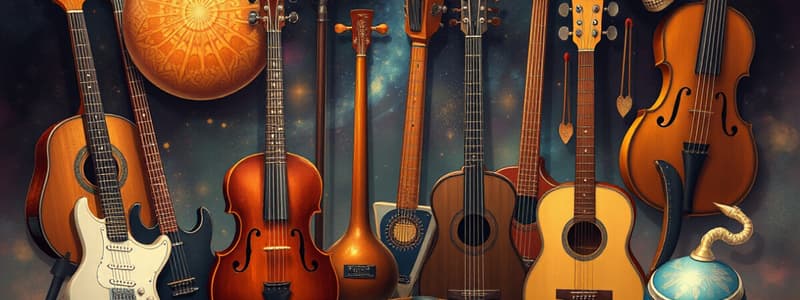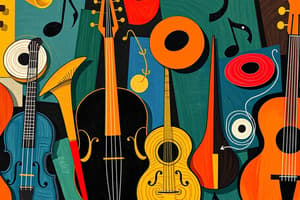Podcast
Questions and Answers
What is a G Melodic minor scale constructed from?
What is a G Melodic minor scale constructed from?
- A natural minor scale (correct)
- A major scale
- A chromatic scale
- A harmonic minor scale
Which interval is considered a major third?
Which interval is considered a major third?
- Three half steps
- Four half steps (correct)
- Seven half steps
- Five half steps
How many half steps are in a minor sixth interval?
How many half steps are in a minor sixth interval?
- Nine half steps
- Eight half steps (correct)
- Six half steps
- Ten half steps
What is the relationship of a diminished fifth interval?
What is the relationship of a diminished fifth interval?
Which interval is considered perfect in music theory?
Which interval is considered perfect in music theory?
What does a major seventh interval consist of?
What does a major seventh interval consist of?
What is the tonic note of the minor key with a key signature of two flats?
What is the tonic note of the minor key with a key signature of two flats?
What is the tonic note of the major key with a key signature of two sharps?
What is the tonic note of the major key with a key signature of two sharps?
Which key signature corresponds to the minor key tonic note of G?
Which key signature corresponds to the minor key tonic note of G?
What is the tonic note of the major key with a key signature of three sharps?
What is the tonic note of the major key with a key signature of three sharps?
What accidental is needed for the note C in the key of B major?
What accidental is needed for the note C in the key of B major?
Which interval corresponds to the term 'Major 6th'?
Which interval corresponds to the term 'Major 6th'?
What is the interval formed between the tonic and the fifth note?
What is the interval formed between the tonic and the fifth note?
Which of the following intervals is a Perfect 4th?
Which of the following intervals is a Perfect 4th?
What is the process called when you transform a musical interval into its opposite?
What is the process called when you transform a musical interval into its opposite?
Which term describes the equivalent note of a note that sounds the same but is written differently?
Which term describes the equivalent note of a note that sounds the same but is written differently?
In order to complete a musical bar, what is needed in addition to the existing notes?
In order to complete a musical bar, what is needed in addition to the existing notes?
Bar lines in music notation serve what primary purpose?
Bar lines in music notation serve what primary purpose?
What is it called when a specific rhythm is organized into smaller segments with lines?
What is it called when a specific rhythm is organized into smaller segments with lines?
When adding a note to a beat, what should be considered to ensure musical completeness?
When adding a note to a beat, what should be considered to ensure musical completeness?
What must be included before stating the melody or rhythm in musical notation?
What must be included before stating the melody or rhythm in musical notation?
In which situation would you typically need to know the enharmonic equivalent of a note?
In which situation would you typically need to know the enharmonic equivalent of a note?
What should be added to the marked place to complete the bar?
What should be added to the marked place to complete the bar?
Which clef should be used to construct a B major scale as mentioned?
Which clef should be used to construct a B major scale as mentioned?
What is indicated by the instruction 'add bar lines'?
What is indicated by the instruction 'add bar lines'?
Which signature is relevant for constructing a D Harmonic minor scale?
Which signature is relevant for constructing a D Harmonic minor scale?
What time signature is being referred to when requesting to prefix the excerpts?
What time signature is being referred to when requesting to prefix the excerpts?
Which action is required to reflect the time signature in an excerpt?
Which action is required to reflect the time signature in an excerpt?
What is the main goal of constructing a scale using the bass clef?
What is the main goal of constructing a scale using the bass clef?
For the key signature to be used ascending, which scale is specified?
For the key signature to be used ascending, which scale is specified?
Which of the following is an example of a percussion instrument?
Which of the following is an example of a percussion instrument?
Which element of music refers to the speed of a piece?
Which element of music refers to the speed of a piece?
Which term indicates a soft volume level in music?
Which term indicates a soft volume level in music?
Which of the following is not a category of Western musical instruments?
Which of the following is not a category of Western musical instruments?
Which of the following elements of music could be represented by the terms 'forte' and 'piano'?
Which of the following elements of music could be represented by the terms 'forte' and 'piano'?
Which term defines a slow tempo in music?
Which term defines a slow tempo in music?
What is one category of Western musical instruments that includes instruments like the flute?
What is one category of Western musical instruments that includes instruments like the flute?
Which musical term indicates a moderately slow tempo?
Which musical term indicates a moderately slow tempo?
Flashcards are hidden until you start studying
Study Notes
Musical Instruments and Groups
- Xylophone, drums, seperewa, and alenleben represent different categories of musical instruments.
- Categorizing instruments aids in understanding their functions and cultural significance.
Elements of Music
- Four key elements of music include melody, harmony, rhythm, and dynamics.
- These elements serve as the foundation for musical composition and expression.
Tempo and Dynamic Indicators
- Dynamic indicators include forte (loud), piano (soft).
- Tempo indicators include largo (slow), moderato (moderate pace).
- Understanding these terms is crucial for interpretation and performance of music.
Categories of Western Musical Instruments
- Strings: Example - Violin
- Woodwinds: Example - Clarinet
- Brass: Example - Trumpet
- Percussion: Example - Snare drum
- Keyboard: Example - Piano
- Recognizing categories helps in learning their unique sound production and roles in ensembles.
Musical Notation and Key Signatures
- Tonic note in a minor key is indicated with two flats for (a) and three flats for (c).
- Tonic note in a major key uses two sharps for (b) and three sharps for (d).
- Key signatures are vital for understanding the tonal center of a piece.
Intervals in Music
- Major 6th, Perfect 5th, and Perfect 4th intervals are integral to melody and harmony.
- Recognizing and naming intervals helps in music composition and ear training.
Time Signatures and Rhythms
- Time signatures are essential for understanding the structure of music; prefixing is necessary for clarity.
- Adding bars and rests completes musical phrases and ensures proper rhythmic execution.
Enharmonic Equivalents
- Understanding enharmonic equivalents (notes that sound the same but are written differently) is vital for reading music.
- Essential for musicians navigating different key signatures and notation systems.
By mastering these concepts and terminologies, students enhance their musical knowledge, skill, and appreciation.
Studying That Suits You
Use AI to generate personalized quizzes and flashcards to suit your learning preferences.




